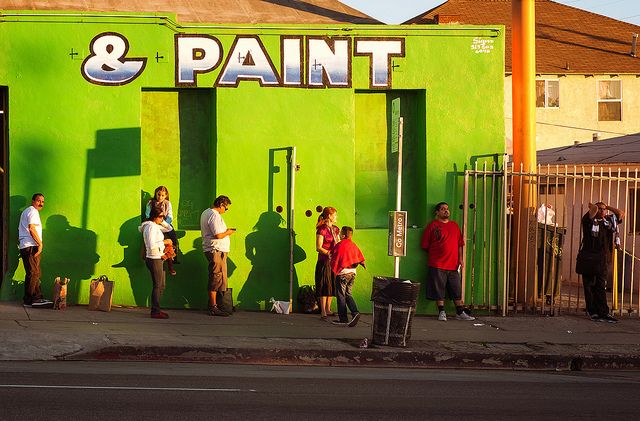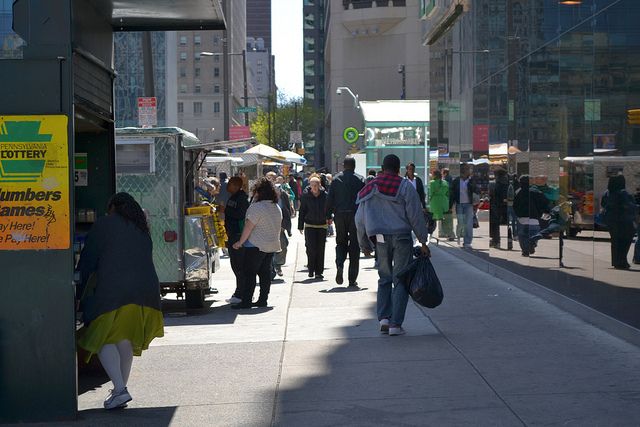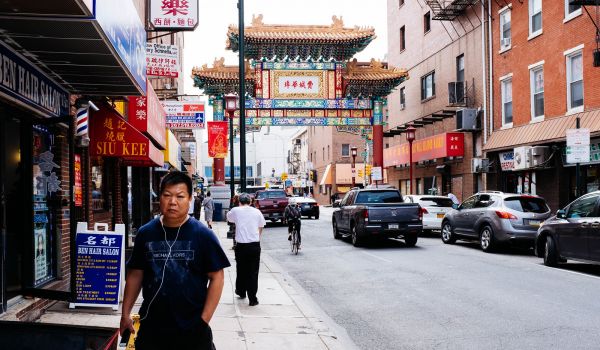People develop, not places. That is the lesson economic geographer Jim Russell has been teaching readers of his Burgh Diaspora blog since 2006, and more recently, the readers of Pacific Standard. What sounds like an obvious point, however, turns out to have many counterintuitive implications for cities when Russell unpacks it.
Here, Russell shares his insights about Philadelphia’s evolving economy. Among them are three requests for city leaders: Stop worrying about brain drain, stop trying to compete with nearby metros for residents, and stop equating physical development with economic development.
Next City: What economic advantages do you think smaller cities like Philadelphia have going for it over larger cities like New York City?
Jim Russell: Philadelphia’s advantage is talent production. As many people know, Philadelphia has a wealth of colleges and universities, and it definitely feeds a lot of large markets with world-class talent. There aren’t many cities in the world that produce talent as well or as prolifically as Philadelphia. You could probably name four or five cities that are tops in the world for what I would call a “higher education cluster,” and Philadelphia is definitely in there. So that’s a big advantage, and really quite distinct from what’s going on in New York.
Now in a larger context, in terms of what advantage Philadelphia has over other U.S. cities and cities around the globe, is its proximity and relationship with New York. New York is the most economically dynamic city in the world, London being a pretty close second. But in many ways it’s difficult to separate New York from London — it’s like one big city with intense linkages across the Atlantic Ocean. It is a huge advantage for Philadelphia to be tied into that as deeply as it is.
NC: What do you think Philadelphia could be doing to further develop some of these advantages?
Russell: I think a first step would be recognizing New York City not as a competitor but as an economic development asset. Think about the relationship with New York, think about those linkages, and how much talent churn there is between the two cities, and develop opportunities based on that intense interaction. Understand that what is good for New York is definitely good for Philadelphia, and vice versa. Think about the economy that happens between two places, instead of focusing on the economy that’s just happening within the metro area — whether it’s urban core activity or suburban, and those kinds of regional issues.
A second step is to recognize that exporting talent is a huge competitive advantage. The fact that Philadelphia is renowned for its “brain drain” is actually a metric of tremendous success. Because Philadelphia educates its residents so well, it’s becoming an attractive location for a number of large firms who are realizing that locating close to these organic talent production institutions means they can depend on a steady supply of talent.
NC: Many cities and regions may not see brain drain as an asset because so much of the discourse on education and economic development takes place within the frame of the city budget. City leaders worry about talented individuals graduating and leaving the city for New York or the suburbs. It may be a benefit in a macro sense over the long term, but if the city can’t capture the fruits of the taxpayers’ investment in talent production immediately as tax base, that’s seen as a problem.
Russell: Reading, Pa. saw a substantial population increase between 2000 and 2010. Can we say Reading has been successful just because its population is growing? That’s essentially what civic boosters and many people interested in cities are saying. They’re looking at population metrics and saying “more is better.” But in Reading, even though its population boomed, it went from middling poverty rates to number one in the country. Is that really something worth celebrating?
It’s not as simple as more population growth. You have to disaggregate the population. You can look at domestic migration for Philadelphia — look at roughly 1996 to 2010 — and Philadelphia loses almost 100,000 people, according to IRS data. And people say, “Oh, it’s a loser. It’s not getting people to vote with their feet.”
But from 2000 to 2011, if you look at the migration data for people 25 years and older with a Bachelor’s degree, Philadelphia gained almost 300,000 college-educated workers. Is that brain drain? Obviously not. So Philadelphia city leaders go on and on and on about brain drain, when statistically it doesn’t even exist. And even though I’m arguing for the benefits of brain drain, actual talent exports, Philadelphia is clearly one of the biggest brain gain winners in the entire United States. That story is not being told.

New York and Philadelphia, as seen from space. Credit: NASA Marshall Space Flight Center
NC: What do we know about where those college-educated workers are migrating from?
Russell: I like to look at net migration and gross migration, but prefer gross migration because I don’t really care which way the flow is balanced. The cities that you have a high level of exchange with are important for economic development. Looking at gross migration, New York is far and away the most important for Philadelphia. Number two is D.C., but it’s not even close. More than a quarter of the total migration is going on between New York and Philadelphia. Interestingly, the flow to D.C. when you’re looking at net migration is exceedingly negative. It’s one of the biggest brain drains for Philadelphia. Whereas New York, on net, is one of the biggest brain gains for Philadelphia.
NC: More people leave Philadelphia for Washington, D.C. on net?
Russell: On net, yes. And that was true a while back for New York as well. I expect over time what we’ve seen happen to migration between New York and Philadelphia will also happen with D.C. as D.C. becomes too expensive. We’ll see people graduate from the universities and colleges in Philadelphia, go off to D.C., and then when they get to the phase of their lifecycles where they start thinking about having a family, start looking to the next stage in their careers, they’ll come back to Philadelphia — either because they’re from there, or they went to school there, or both. That’s already happening en masse with New York. Over a 14-year period — 1996 to 2010 — the flow between New York and Philadelphia was about plus 95,000 for Philadelphia.
And you see it in anecdotal stories about Philadelphia: Return migrants who say they’re Brooklyn refugees, they’re tired of the high rents, and they’re populating various neighborhoods in the city where they can find good schools and really nice homes that aren’t ridiculously expensive. And many are keeping their jobs in New York, keeping their networks there, and still doing a lot of their work either via telecommuting or actually physically going to New York. The economies are developing together.
NC: You and I have gone back and forth a bit on this issue, and if I understand your argument correctly it’s that you think that placemaking strategies should not be seen as a substitute for economic development.
Russell: I don’t necessarily think people are arguing that placemaking is a substitute for economic development. I’m trying to help people rethink how placemaking relates to economic development. I think the theory behind placemaking is fundamentally flawed, and that’s because it’s place-centric as opposed to people-centric.
If you’re just looking at a place, you miss a lot of things. You’re focusing on issues like who owns that place. You’re placemaking for the “true” residents. The people who’ve lived there the longest are viewed as the most legitimate stakeholders. People who have a connection to the place but don’t live there don’t count. That’s very troubling. It’s a fundamental misunderstanding of economic development. Thinking about how people move around and how they develop economically as people really has very little to do with placemaking.
We also need to deal with the issue of migration. As an economy such as Philadelphia’s matures, we’re going to see more and more outsiders coming through. That creates social problems and community problems, and I think placemaking can address that. I think of migration as the lifeblood of any city. You don’t have a city unless you have migration. You have to have outsiders, or else it ceases to be cosmopolitan. With more migration you have less social capital. You’re going to have people from another country who’ve been here six months dealing with people who have been in one neighborhood for four generations. How does that work? What kind of problems will you have? Placemaking is well-positioned to deal with these issues.
NC: Gentrification is a term that gets thrown around a lot that I think is ill defined. I hear some people use it as a catchall term for any improvements in a neighborhood or its amenities. “That new coffee shop is gentrifying the neighborhood.” “I picked up some litter, I’m gentrifying this block.” What is your definition of gentrification, just for the sake of clarity?
Russell: I was academically trained as a geographer, and so my understanding of gentrification is similar to geographers such as Neil Smith who look at gentrification as a class issue. What you’re seeing is people with upward mobility displacing people who do not have upward mobility. It is the tension between the mobile and the stuck. It’s essentially spatial class warfare. And I don’t want to say it’s intentional — I don’t want to ascribe agency to gentrifiers. But I think there are large structural forces such as globalization that are driving gentrification and creating clashes of class.
And you can see this everywhere, but it’s primarily happening in inner cities that were once the eddies of national economic activity, and now are the sites of economic globalization. Economies of scale and agglomeration are concentrating wealth in small neighborhoods. You can’t even say globalization is happening in New York, because it’s much more specific than that: Globalization is happening in neighborhoods like Park Slope in Brooklyn. It’s that specific.
It isn’t happening in the poor neighborhoods in Brooklyn. They’re too disconnected. I think we make the mistake of saying “globalization ran roughshod over industrial cities like Detroit and wrecked them,” and that’s just not true. Globalization abandoned them. It had no use for them, so capital stopped flowing there.
NC: How do you think cities should respond when rents start rising?
JR: I think the primary problem with the most distressed neighborhoods is that they’re too disconnected. There’s actually too much social capital. [Residents] only trust their neighbors, won’t talk to people from the outside. That’s where the poverty is and that’s where the problems are. But you can’t open up neighborhoods without first coming up with a plan for how you’re going to deal with gentrification. How do we mitigate the negative effects of gentrification?
What I’m really saying is that we need to get these neighborhoods more connected to migration and to financial capital. They deserve the opportunity to prosper, the opportunity to start businesses. But they also need to become aware of other places – the sense that we can leave, and we can come back and bring with us a college education, global networks, entrepreneurial excitement and prosperity. But opening up neighborhoods can make some people angry when what was once a very humble little neighborhood starts becoming a probing ground of upper-middle-class outsiders.

Boyle Heights. Credit: Sergey Sus on Flickr
NC: You had an interesting post a few weeks ago about Boyle Heights, a Chicano neighborhood in Los Angeles, where people who moved away to go to college and then returned home were resisted as gentrifiers, even though they had grown up there.
JR: Boyle Heights has had lots of different kinds of immigrants through the years, so there’s this fundamental question about who are the “true” residents of the neighborhood, and I think that’s a baloney line of inquiry. There are no “true” residents of a neighborhood. Neighborhoods are dynamic over time. In Boyle Heights you have a very rich, entrenched Chicano culture. It’s famous for that. It’s attractive for that very reason. But it also produced successful people who left for places such as New York, and then came back, and brought back with them the tastes of New York and cosmopolitanism.
And when somebody comes back to start an entrepreneurial investment, he may see it like, “prodigal son comes home from New York to make his home a better place.” But he’s seen as a gentrifier. “You’re wrecking it, you don’t understand what we’re about, you abandoned us.” There’s this whole stigma tied to brain drain. “Whoever leaves, they’re dead to us. They weren’t here for the hard times and how dare they try to claim ownership of this community.”
I don’t see race and class animating the gentrification debate as much as I see xenophobia. It’s just about fear of outsiders — who belongs in the neighborhood and who does not? Anybody who left the neighborhood or didn’t grow up there doesn’t belong in the neighborhood, and if they bring any change that’s seen as negative that’s called “gentrification.” It’s become a dirty word and it’s a way of scapegoating. It’s no different than run-of-the-mill xenophobia like anti-immigrant sentiment. And I think the handwringing over brain drain is primarily an expression of xenophobia. Retention strategies reinforce xenophobic attitudes that native talent is better than outsider talent. That is something I see Philadelphia struggling with.

Jonathan Geeting is a freelance writer based in Philadelphia, where he writes about land use and public space politics. His work appears at Next City, This Old City and Keystone Politics.
















